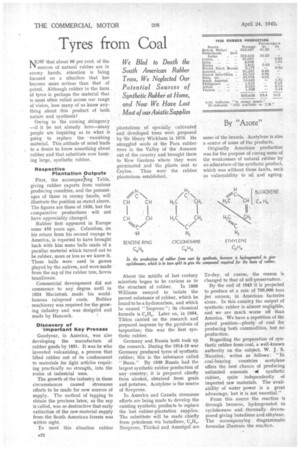Tyres from Coal
Page 24

If you've noticed an error in this article please click here to report it so we can fix it.
We Bled to Death the South American Rubber Trees, We Neglected Our Potential Sources of Synthetic Rubber at Home, and Now We Have Lost Most of our Asiatic Supplies
By "Azote"
NOW that about 90 per cent. of the sources of natural rubber are in enemy hands, attention is being focused on a situation that has become more serious than that of petrol. Although rubber in the form of tyres is perhaps the material that is most often rolled across our range of vision, how many of us know anything about this product of both nature and synthesis?
Owing to the coming stringency —if it be not already here—many people are inquiring as to what is going to replace the • vanishing material. This attitude of mind leads to a desire to know something about rubber and that substitute now looming large, synthetic rubber.
Respective Plantation Outputs First, the accompanying Table, giving rubber exports from various producing countries, and the percentages of those in enemy hands, will illustrate the position as stated above. The figures are those of 1936, but the comparative productions will not have appreciably changed.
Rubber first appeared in Europe some 450 years ago. Columbus, on his return from his second voyage to America, is reported to have brought back With him some balls made of a peculiar material which turned out to be rubber, more or less as we know it. These balls were used in games played by the natives, and were made' from the sap of the rubber tree, hevea brasiliensis.
Commercial development did not commence to any degree until in 1824 Macintosh made his worldfamous rainproof coats. Rubber machinery was required for the growing industry and was designed and
made by Hancock. 7
Discovery of 'Important Key Process Goodyear, in America, was also developing the manufacture of rubber goods by 1831. It was he who invented vulcanizing, a process that lifted rubber out of its confinement to materials for light articles requiring practically no strength, into the realm of industrial uses.
The growth of the industry in these circumstances caused strenuous efforts to be made for new sources of supply. The method of tapping to obtain the precious latex, as the sap is called, was so destructive that early extinction of the raw-material supply from the South American forests was within sight.
To meet this situation rubber plantations of specially cultivated and developed trees were proposed by Sir Henry Wickham in 1876. He smuggled seeds of the Para rubber trees in the Valley of the Amazon out of the country and brought them to Kew Gardens where they were germinated and the plants sent to Ceylon. Thus were the rubber plantations established.
About the middle of last century scientists began to be curious as to the structure of rubber. In 1860 Williams essayed to isolate the parent substance of rubber,. which he found to be a hydrocarbon, and which he named " Isoprene "; its chemical formula is C,H„ Later on, in 1884, Tilden carried on the research and prepared isoprene by the p3rrolesis of turpentine; this was the first synthetic rubber.
Germany and Russia both took up the research. During the 1914-18 war Germany produced tyres of synthetic rubber; this is the substance called " Blum." By 1930 Russia had the largest synthetic rubber production of any country; it is prepared chiefly from alcohol, obtained from grain and potatoes. Acetylene is the source of Sovprene.
In America and Canada strenuous efforts are being made to develop the existing synthetic products to replace the lost rubber-plantation supplies. The substitute will be made chiefly from petroleum via butadiene, C,Ho. Neoprene, Thiokol and Ameripol are
some of the brands. Acetylene is also a source of some of the products.
Originally American production was for the purpose of curing some of the weaknesses of natural rubber by an admixture of the synthetic product, which was without those faults, such as vulnerability to oil and ageing.
To-day, of course, the reason is changed to that of self-preservation.
By the end of 1943 it is projected to produce at a. rate of 700,000 tons tier annum, in American factories alone. In this country the output of synthetic rubber is almost negligible, and we are much worse off than America. We have a repetition of the petrol position—plenty of coal for producing both commodities, but no production.
Regarding the preparation of synthetic rubber from coal, a well-known authority on the subject, W. J. S. Naunton, writes as follows : " In coal-bearing countries acetylene offers the best chance of producing unlimited amounts synthetic rubber, quite independently of imported raw materials. The availability of water power is a great advantage, but it is not essential." .
From this source the reaction is through benzene, hydrogenated to cyclohexane and thermally decomposed giving butadiene and ethylene,. The accompanying diagrammatic formulae illustrate the reaction.




















































